Reflective Writing: Teaching Grammar and Student Learning Outcomes
VerifiedAdded on 2020/03/16
|6
|1275
|83
Journal and Reflective Writing
AI Summary
This reflective writing piece examines the author's experiences and reflections on teaching grammar, focusing on an indirect approach using classroom activities like writing examples, video sessions, and reading sessions. The author used real-life communication techniques, influenced by Krashen's theories, to enhance student engagement and understanding. The assignment involved teaching students about water conservation through research, discussions, and writing in the present simple tense. The writing compares this approach with a humanistic, genre-based method, discussing their strengths and weaknesses, including challenges related to student focus, the role of grammar syllabi, and the limitations of incidental learning. The author concludes by advocating for context-related grammar teaching that meets both academic and real-life communication needs, suggesting the use of closed approaches for everyday communication and emphasizing the benefits of group learning to enhance understanding.
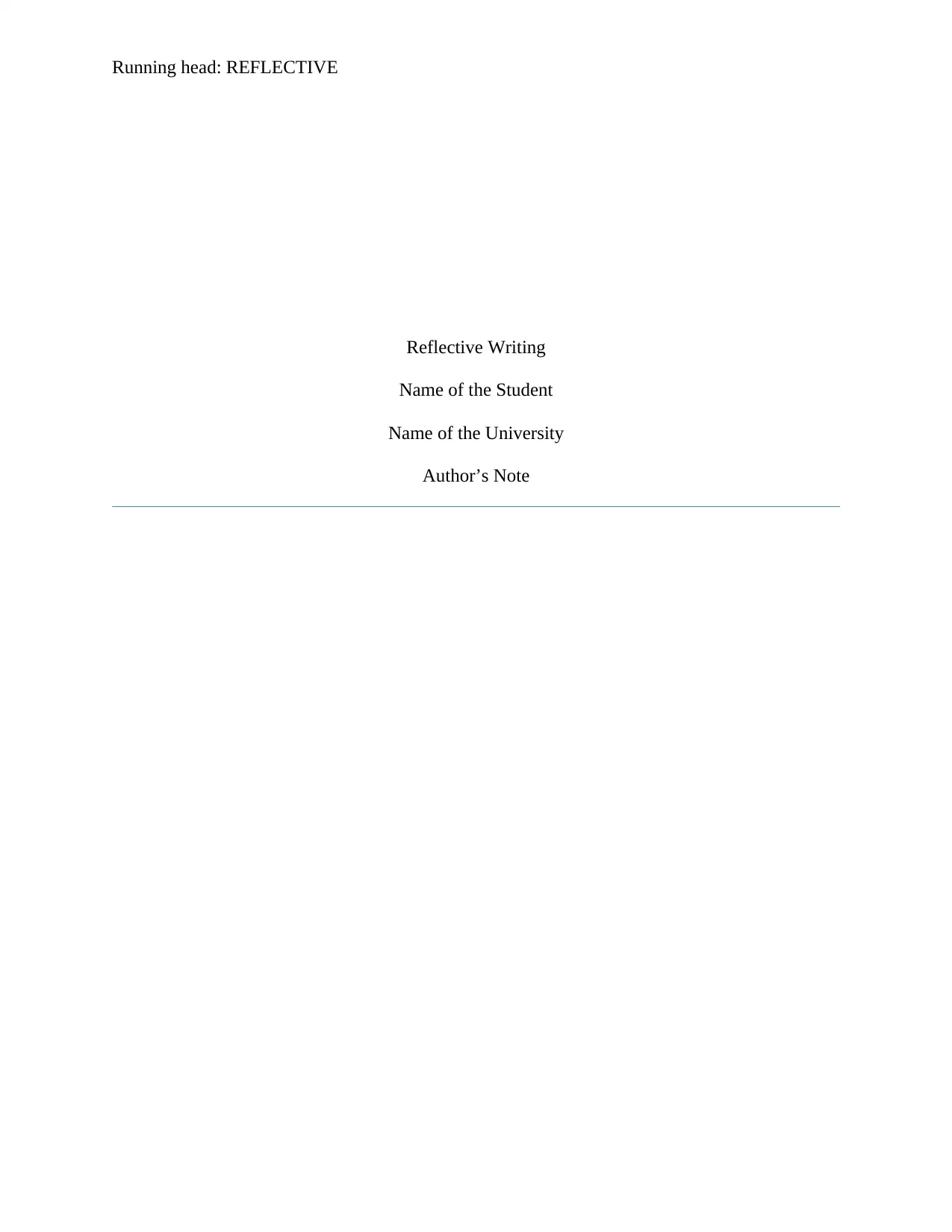
Running head: REFLECTIVE
Reflective Writing
Name of the Student
Name of the University
Author’s Note
Reflective Writing
Name of the Student
Name of the University
Author’s Note
Paraphrase This Document
Need a fresh take? Get an instant paraphrase of this document with our AI Paraphraser
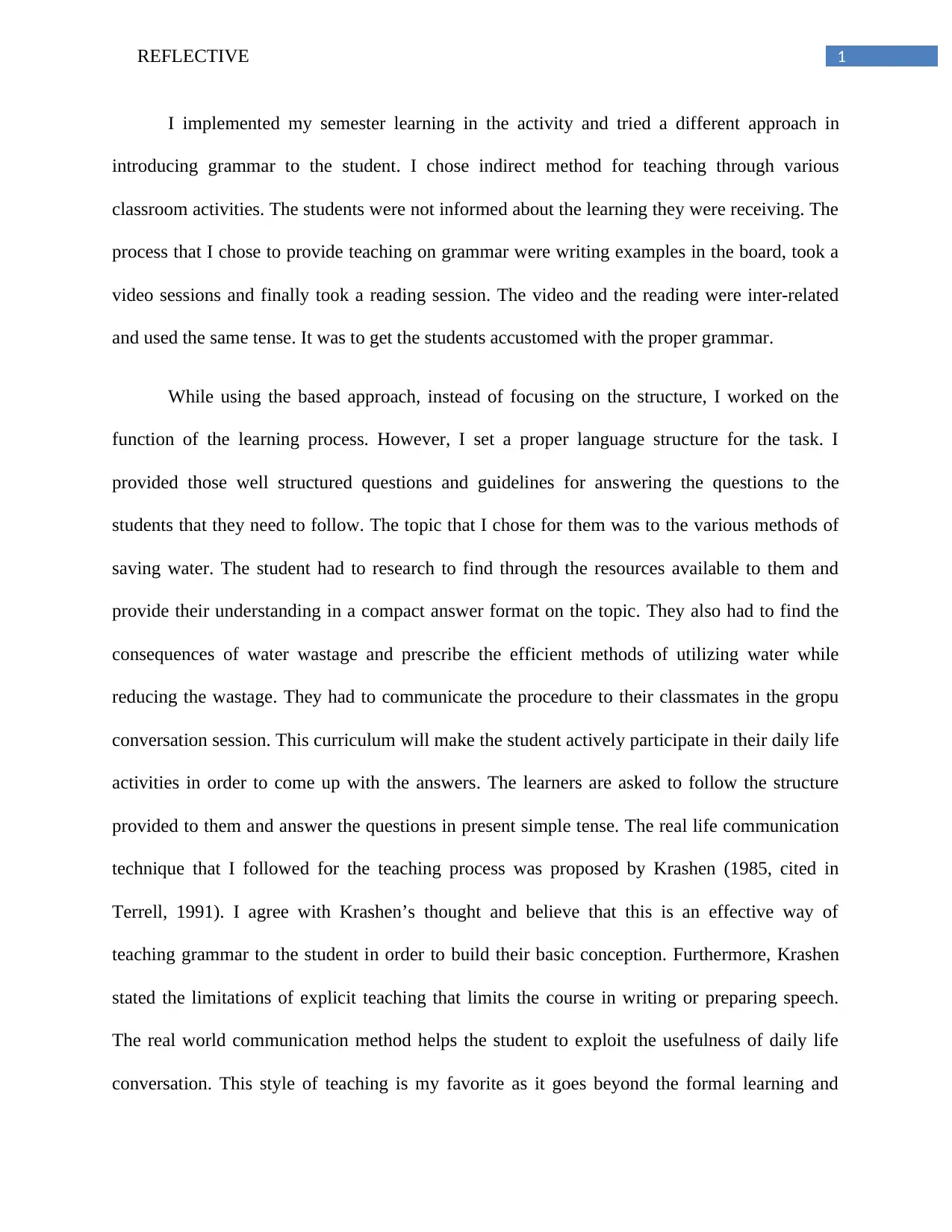
1REFLECTIVE
I implemented my semester learning in the activity and tried a different approach in
introducing grammar to the student. I chose indirect method for teaching through various
classroom activities. The students were not informed about the learning they were receiving. The
process that I chose to provide teaching on grammar were writing examples in the board, took a
video sessions and finally took a reading session. The video and the reading were inter-related
and used the same tense. It was to get the students accustomed with the proper grammar.
While using the based approach, instead of focusing on the structure, I worked on the
function of the learning process. However, I set a proper language structure for the task. I
provided those well structured questions and guidelines for answering the questions to the
students that they need to follow. The topic that I chose for them was to the various methods of
saving water. The student had to research to find through the resources available to them and
provide their understanding in a compact answer format on the topic. They also had to find the
consequences of water wastage and prescribe the efficient methods of utilizing water while
reducing the wastage. They had to communicate the procedure to their classmates in the gropu
conversation session. This curriculum will make the student actively participate in their daily life
activities in order to come up with the answers. The learners are asked to follow the structure
provided to them and answer the questions in present simple tense. The real life communication
technique that I followed for the teaching process was proposed by Krashen (1985, cited in
Terrell, 1991). I agree with Krashen’s thought and believe that this is an effective way of
teaching grammar to the student in order to build their basic conception. Furthermore, Krashen
stated the limitations of explicit teaching that limits the course in writing or preparing speech.
The real world communication method helps the student to exploit the usefulness of daily life
conversation. This style of teaching is my favorite as it goes beyond the formal learning and
I implemented my semester learning in the activity and tried a different approach in
introducing grammar to the student. I chose indirect method for teaching through various
classroom activities. The students were not informed about the learning they were receiving. The
process that I chose to provide teaching on grammar were writing examples in the board, took a
video sessions and finally took a reading session. The video and the reading were inter-related
and used the same tense. It was to get the students accustomed with the proper grammar.
While using the based approach, instead of focusing on the structure, I worked on the
function of the learning process. However, I set a proper language structure for the task. I
provided those well structured questions and guidelines for answering the questions to the
students that they need to follow. The topic that I chose for them was to the various methods of
saving water. The student had to research to find through the resources available to them and
provide their understanding in a compact answer format on the topic. They also had to find the
consequences of water wastage and prescribe the efficient methods of utilizing water while
reducing the wastage. They had to communicate the procedure to their classmates in the gropu
conversation session. This curriculum will make the student actively participate in their daily life
activities in order to come up with the answers. The learners are asked to follow the structure
provided to them and answer the questions in present simple tense. The real life communication
technique that I followed for the teaching process was proposed by Krashen (1985, cited in
Terrell, 1991). I agree with Krashen’s thought and believe that this is an effective way of
teaching grammar to the student in order to build their basic conception. Furthermore, Krashen
stated the limitations of explicit teaching that limits the course in writing or preparing speech.
The real world communication method helps the student to exploit the usefulness of daily life
conversation. This style of teaching is my favorite as it goes beyond the formal learning and

2REFLECTIVE
makes it enjoyable for them. It is because the process of learning does not involve only reading
or learning and the students learn most of the things unintentionally. Another benefit of this
process comes from the involvement of culture which is an integral part of language. This
process will help the students gathering more knowledge and ready for their future life.
The content of the assignment 2a was the indirect application of grammar. I used the
same structure for my activity and provided the structure to the student. The students followed
the same structure for the completion of their academic work. As I mentioned earlier, this
particular activity is my favorite because of its consideration of grammar and structure for
academic context and develops students’ skills. Usefulness of these skills goes beyond the
academic boundaries as the students can apply them on their social life. It enables the students to
refer literature or use it for referencing anything they like in their life. However, it is limited due
to its isolative nature and the students have to struggle synthesizing their learning (Christison &
Murray, 2014).
The Assignment 2b was Humanistic approach that was negotiated by the students. Student’s
psychological dimensions and intellectual abilities were developed through this assignment.
The students had to use my structure in the Genre Approach directly to pattern my
examples to initiate conversations in the group.
The examples in indirect implication of grammar point were academic and
contextualized. My goal of this activity was to introduce the students to the simple present tense.
I addressed the issues of the process that are schematic structured conversations, ignorance of
content and placing emphasis on features of the genre. These plays important role in distracting
students and restrict them from discovering the actual message of the text and neglects other
makes it enjoyable for them. It is because the process of learning does not involve only reading
or learning and the students learn most of the things unintentionally. Another benefit of this
process comes from the involvement of culture which is an integral part of language. This
process will help the students gathering more knowledge and ready for their future life.
The content of the assignment 2a was the indirect application of grammar. I used the
same structure for my activity and provided the structure to the student. The students followed
the same structure for the completion of their academic work. As I mentioned earlier, this
particular activity is my favorite because of its consideration of grammar and structure for
academic context and develops students’ skills. Usefulness of these skills goes beyond the
academic boundaries as the students can apply them on their social life. It enables the students to
refer literature or use it for referencing anything they like in their life. However, it is limited due
to its isolative nature and the students have to struggle synthesizing their learning (Christison &
Murray, 2014).
The Assignment 2b was Humanistic approach that was negotiated by the students. Student’s
psychological dimensions and intellectual abilities were developed through this assignment.
The students had to use my structure in the Genre Approach directly to pattern my
examples to initiate conversations in the group.
The examples in indirect implication of grammar point were academic and
contextualized. My goal of this activity was to introduce the students to the simple present tense.
I addressed the issues of the process that are schematic structured conversations, ignorance of
content and placing emphasis on features of the genre. These plays important role in distracting
students and restrict them from discovering the actual message of the text and neglects other
⊘ This is a preview!⊘
Do you want full access?
Subscribe today to unlock all pages.

Trusted by 1+ million students worldwide
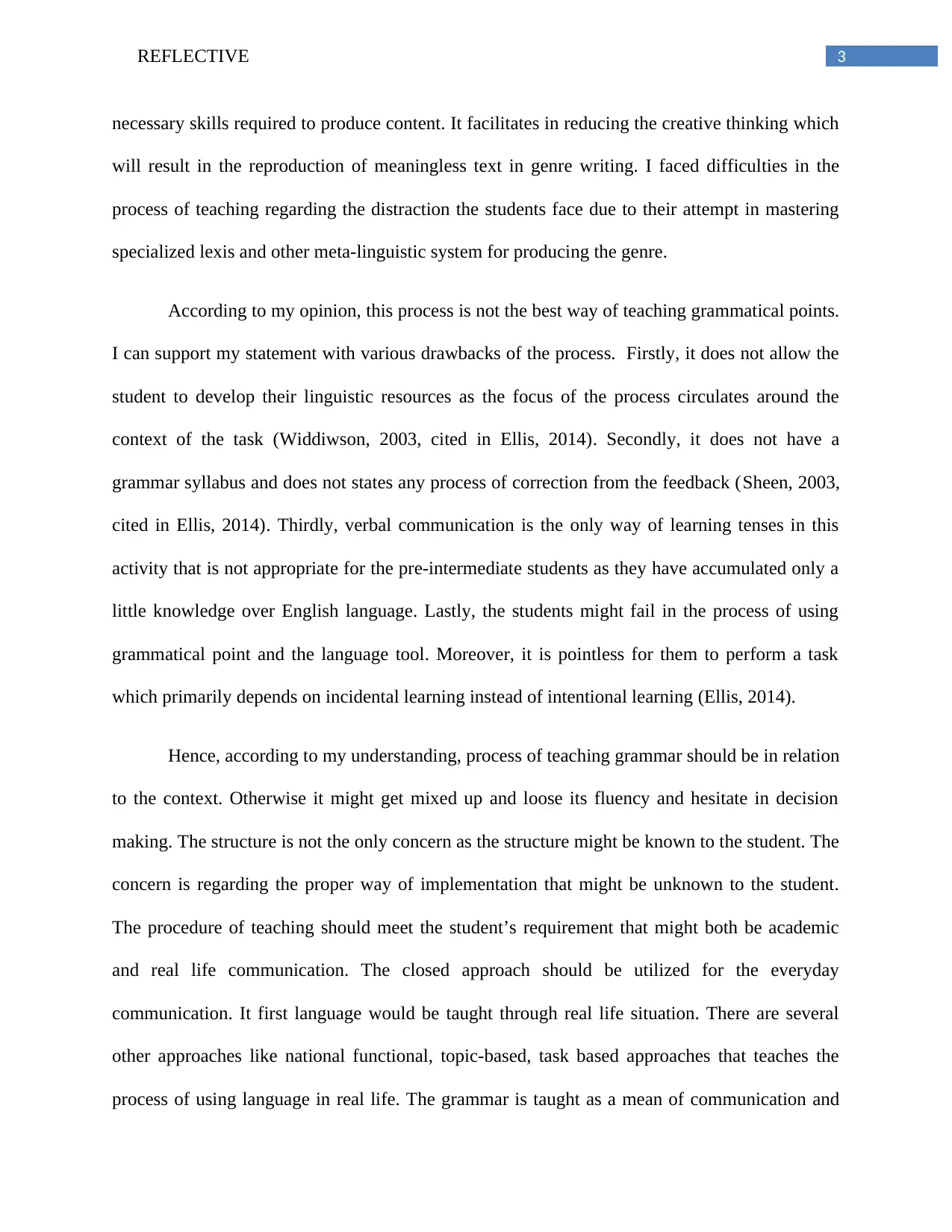
3REFLECTIVE
necessary skills required to produce content. It facilitates in reducing the creative thinking which
will result in the reproduction of meaningless text in genre writing. I faced difficulties in the
process of teaching regarding the distraction the students face due to their attempt in mastering
specialized lexis and other meta-linguistic system for producing the genre.
According to my opinion, this process is not the best way of teaching grammatical points.
I can support my statement with various drawbacks of the process. Firstly, it does not allow the
student to develop their linguistic resources as the focus of the process circulates around the
context of the task (Widdiwson, 2003, cited in Ellis, 2014). Secondly, it does not have a
grammar syllabus and does not states any process of correction from the feedback (Sheen, 2003,
cited in Ellis, 2014). Thirdly, verbal communication is the only way of learning tenses in this
activity that is not appropriate for the pre-intermediate students as they have accumulated only a
little knowledge over English language. Lastly, the students might fail in the process of using
grammatical point and the language tool. Moreover, it is pointless for them to perform a task
which primarily depends on incidental learning instead of intentional learning (Ellis, 2014).
Hence, according to my understanding, process of teaching grammar should be in relation
to the context. Otherwise it might get mixed up and loose its fluency and hesitate in decision
making. The structure is not the only concern as the structure might be known to the student. The
concern is regarding the proper way of implementation that might be unknown to the student.
The procedure of teaching should meet the student’s requirement that might both be academic
and real life communication. The closed approach should be utilized for the everyday
communication. It first language would be taught through real life situation. There are several
other approaches like national functional, topic-based, task based approaches that teaches the
process of using language in real life. The grammar is taught as a mean of communication and
necessary skills required to produce content. It facilitates in reducing the creative thinking which
will result in the reproduction of meaningless text in genre writing. I faced difficulties in the
process of teaching regarding the distraction the students face due to their attempt in mastering
specialized lexis and other meta-linguistic system for producing the genre.
According to my opinion, this process is not the best way of teaching grammatical points.
I can support my statement with various drawbacks of the process. Firstly, it does not allow the
student to develop their linguistic resources as the focus of the process circulates around the
context of the task (Widdiwson, 2003, cited in Ellis, 2014). Secondly, it does not have a
grammar syllabus and does not states any process of correction from the feedback (Sheen, 2003,
cited in Ellis, 2014). Thirdly, verbal communication is the only way of learning tenses in this
activity that is not appropriate for the pre-intermediate students as they have accumulated only a
little knowledge over English language. Lastly, the students might fail in the process of using
grammatical point and the language tool. Moreover, it is pointless for them to perform a task
which primarily depends on incidental learning instead of intentional learning (Ellis, 2014).
Hence, according to my understanding, process of teaching grammar should be in relation
to the context. Otherwise it might get mixed up and loose its fluency and hesitate in decision
making. The structure is not the only concern as the structure might be known to the student. The
concern is regarding the proper way of implementation that might be unknown to the student.
The procedure of teaching should meet the student’s requirement that might both be academic
and real life communication. The closed approach should be utilized for the everyday
communication. It first language would be taught through real life situation. There are several
other approaches like national functional, topic-based, task based approaches that teaches the
process of using language in real life. The grammar is taught as a mean of communication and
Paraphrase This Document
Need a fresh take? Get an instant paraphrase of this document with our AI Paraphraser
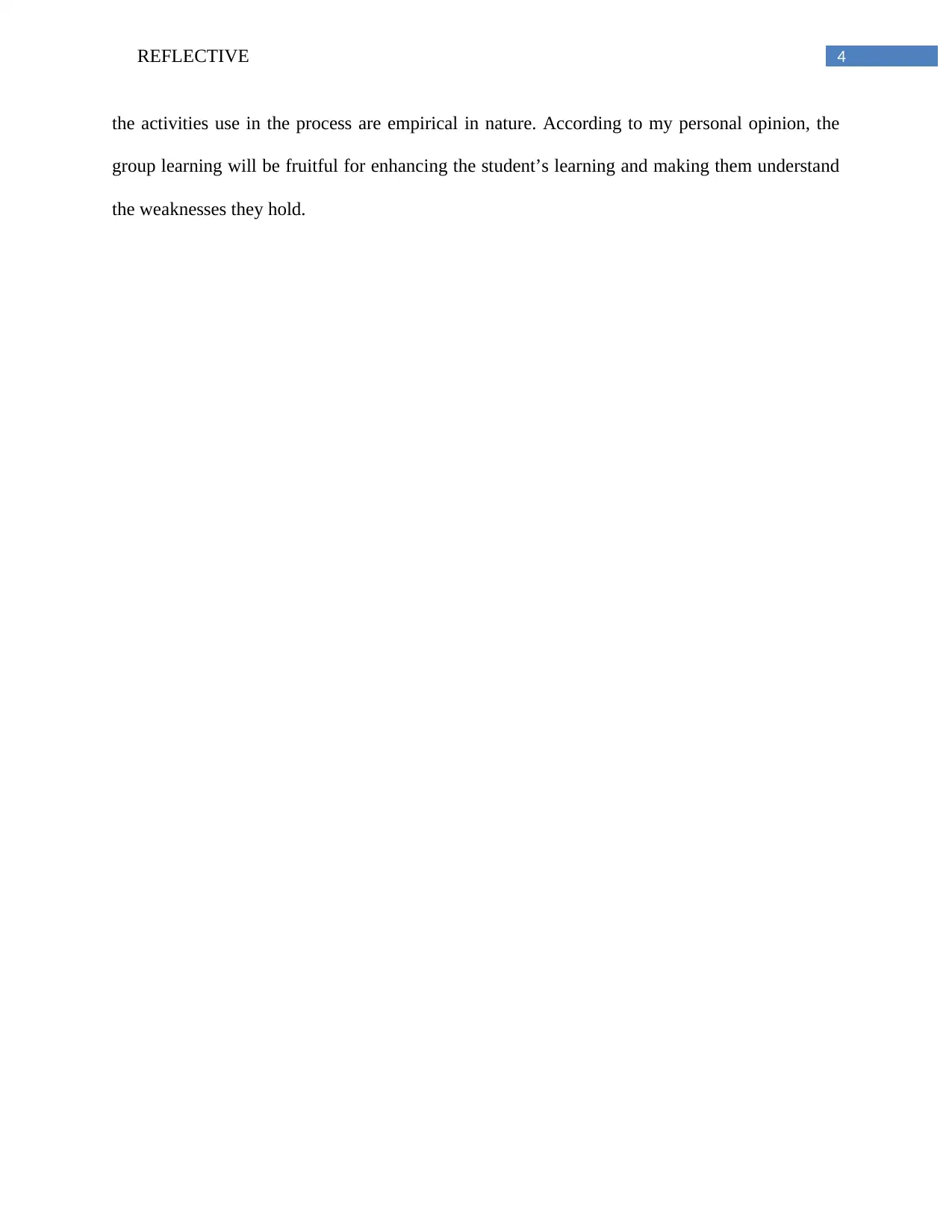
4REFLECTIVE
the activities use in the process are empirical in nature. According to my personal opinion, the
group learning will be fruitful for enhancing the student’s learning and making them understand
the weaknesses they hold.
the activities use in the process are empirical in nature. According to my personal opinion, the
group learning will be fruitful for enhancing the student’s learning and making them understand
the weaknesses they hold.
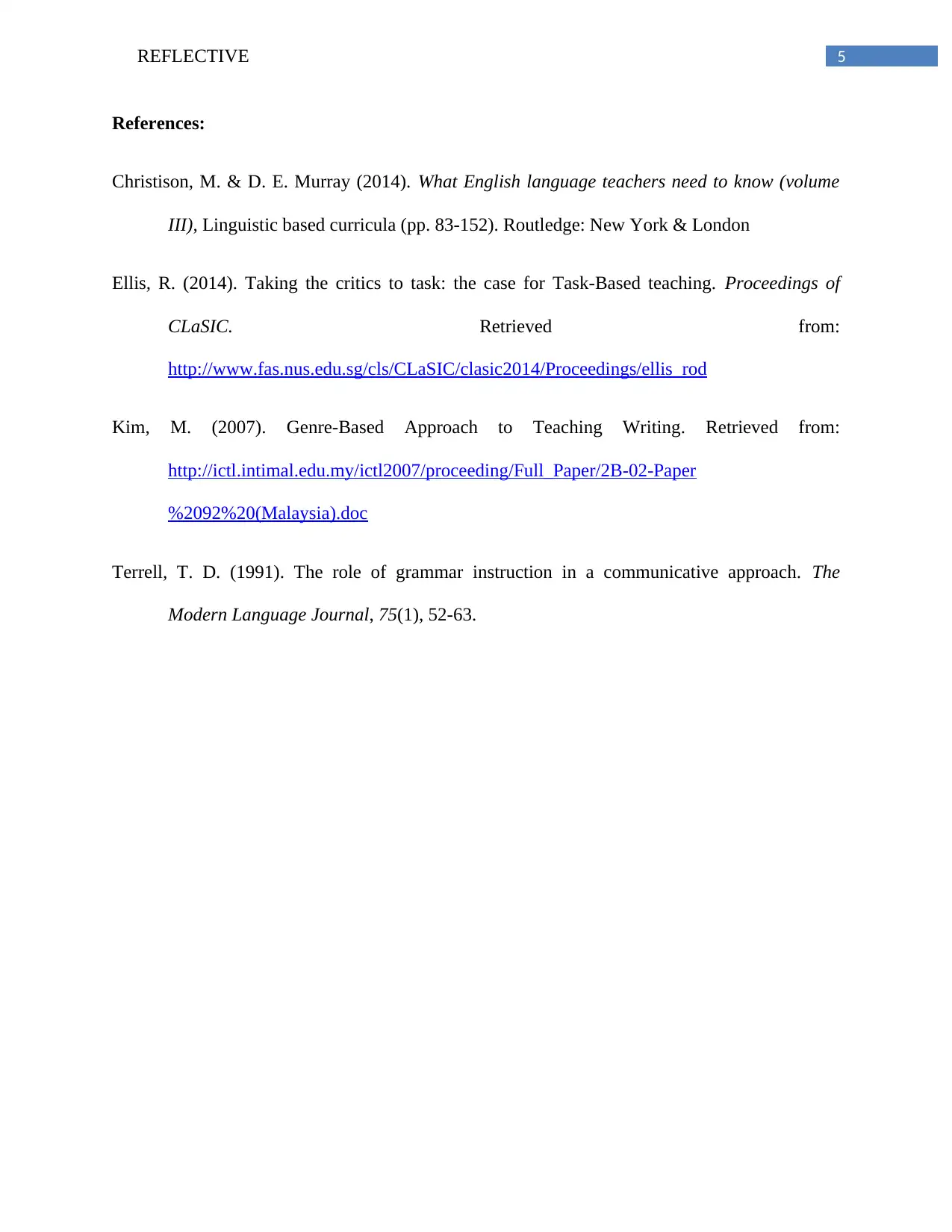
5REFLECTIVE
References:
Christison, M. & D. E. Murray (2014). What English language teachers need to know (volume
III), Linguistic based curricula (pp. 83-152). Routledge: New York & London
Ellis, R. (2014). Taking the critics to task: the case for Task-Based teaching. Proceedings of
CLaSIC. Retrieved from:
http://www.fas.nus.edu.sg/cls/CLaSIC/clasic2014/Proceedings/ellis_rod
Kim, M. (2007). Genre-Based Approach to Teaching Writing. Retrieved from:
http://ictl.intimal.edu.my/ictl2007/proceeding/Full_Paper/2B-02-Paper
%2092%20(Malaysia).doc
Terrell, T. D. (1991). The role of grammar instruction in a communicative approach. The
Modern Language Journal, 75(1), 52-63.
References:
Christison, M. & D. E. Murray (2014). What English language teachers need to know (volume
III), Linguistic based curricula (pp. 83-152). Routledge: New York & London
Ellis, R. (2014). Taking the critics to task: the case for Task-Based teaching. Proceedings of
CLaSIC. Retrieved from:
http://www.fas.nus.edu.sg/cls/CLaSIC/clasic2014/Proceedings/ellis_rod
Kim, M. (2007). Genre-Based Approach to Teaching Writing. Retrieved from:
http://ictl.intimal.edu.my/ictl2007/proceeding/Full_Paper/2B-02-Paper
%2092%20(Malaysia).doc
Terrell, T. D. (1991). The role of grammar instruction in a communicative approach. The
Modern Language Journal, 75(1), 52-63.
⊘ This is a preview!⊘
Do you want full access?
Subscribe today to unlock all pages.

Trusted by 1+ million students worldwide
1 out of 6
Related Documents
Your All-in-One AI-Powered Toolkit for Academic Success.
+13062052269
info@desklib.com
Available 24*7 on WhatsApp / Email
![[object Object]](/_next/static/media/star-bottom.7253800d.svg)
Unlock your academic potential
Copyright © 2020–2025 A2Z Services. All Rights Reserved. Developed and managed by ZUCOL.





